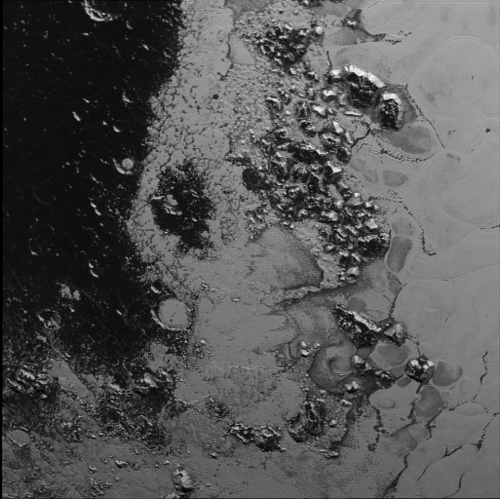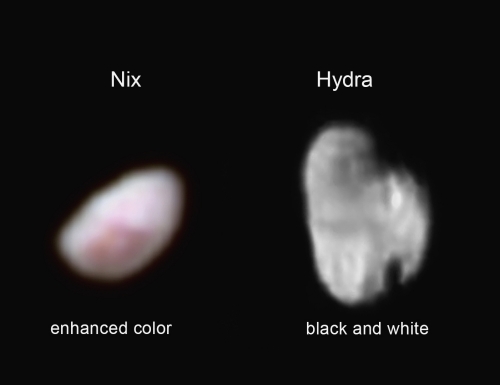We’ve already had the pleasure of naming features on Pluto, at least informally, highlighted by the moment when the heart-shaped area revealed by New Horizons was named Tombaugh Regio, after the world’s discoverer. The fact that two of Clyde Tombaugh’s children were in the audience during the news briefing where this occurred made it all the more powerful. Now we are turning to smaller features, as witness the mountain range near the southwest margin of Tombaugh Regio, viewed by New Horizons from a distance of 77,000 kilometers on July 20.

Image: What a glorious view on what had previously been nothing more than a barely resolved dot. This is the region of Tombaugh Regio containing a range of mountains evidently less elevated than those previously seen near Pluto’s equator (see First Post-Flyby Imager). Features as small as one kilometers across are visible in this image. Credit: NASA/JHUAPL/SWRI.
The mountains in the equatorial region — now known as Norgay Montes, after sherpa Tenzing Norgay — rise as high as 3500 meters, and evidently formed no more than 100 million years ago, an indication that they may still be in a geologically active area (the debate on the matter should be lively). The new range is west of the region now called Sputnik Planum, some 110 kilometers northwest of Norgay Montes. These peaks reach between 1 and 1.5 kilometers in height. This NASA news release likens them to the Appalachian Mountains of the US, compared to the loftier Norgay Montes region with peaks similar to those in the Rockies.
We’re also seeing interesting topography along the western edge of Tombaugh Regio, as Jeff Moore (NASA Ames), who leads the New Horizons Geology, Geophysics and Imaging Team (GGI), points out:
“There is a pronounced difference in texture between the younger, frozen plains to the east and the dark, heavily-cratered terrain to the west. There’s a complex interaction going on between the bright and the dark materials that we’re still trying to understand.”
If Sputnik Planum is thought to be less than 100 million years old, the darker region probably goes back billions of years. Moore notes the bright, sediment-like material that seems to be filling in the older craters — see the circular feature to the lower left of center in the image.
Glimpses of Pluto’s Moons
While Charon obviously took pride of place in the New Horizons flyby, the lesser satellites were not neglected, as we see in the just released imagery of Nix and Hydra. These were the second and third moons to be discovered respectively, and they are of roughly the same size. But just as both Pluto and Charon have already delivered their share of surprises, so has Nix, which sports a region with a reddish tint and patterning that suggests the area is a crater. Nix is, overall, gray, but the red tint is obvious in the first color image of Nix, with colors enhanced.

Image: Pluto’s moon Nix (left), shown here in enhanced color as imaged by the New Horizons Ralph instrument, has a reddish spot that has attracted the interest of mission scientists. The data were obtained on the morning of July 14, 2015, and received on the ground on July 18. At the time the observations were taken New Horizons was about 165,000 km from Nix. The image shows features as small as approximately 3 kilometers across on Nix, which is estimated to be 42 kilometers long and 36 kilometers wide. Pluto’s small, irregularly shaped moon Hydra (right) is revealed in this black and white image taken from New Horizons’ LORRI instrument on July 14, 2015 from a distance of about 231,000 kilometers. Features as small as 1.2 kilometers are visible on Hydra, which measures 55 kilometers in length. Credit: NASA/JHUAPL/SWRI.
On Hydra (which NASA’s news release likens to the US state of Michigan in terms of its shape), we can see two evident craters, one largely in shadow. Here again we seem to have differences in surface composition, to judge from the darker aspect of the upper portion of the moon.
“Before last week, Hydra was just a faint point of light, so it’s a surreal experience to see it become an actual place, as we see its shape and spot recognizable features on its surface for the first time,” said mission science collaborator Ted Stryk (Roane State Community College, Tennessee).
Indeed. But that’s been the experience of this entire flyby, with puzzling terrain, striking mountains, and satellite features that will long keep us occupied. When I think about how much New Horizons has already brought us, I’m reminded to send you to Kenneth Chang’s fine piece in the New York Times on the history of New Horizons. This is a mission that was threatened from the beginning by everything from budget problems to plutonium sourcing, and but for the tenacity of those who believed in it, we wouldn’t be having this discussion. “If you wrote a novel about it, I don’t think people would buy it,” said mission PI Alan Stern, and rightly so. Don’t miss Chang’s The Long Strange Trip to Pluto, and How NASA Nearly Missed It.



Irony runs rampant! Hydra looks(shapewise)like a scaled UP version of P67 whereas Nix is a scaled DOWN version of Humaya, SHAPEWISE AND COLORWISE. It would get VERY IRONIC INDEED if spectral analyses of Nix’s and Humaya’s red spots prove to be similar!
Irony? About as much as an Alanis Morissette song…
New Horizons encounter plus one week: Weird and wonderful images from the Pluto system
Posted By Emily Lakdawalla
2015/07/21 23:39 UTC
Topics: trans-neptunian objects, New Horizons, pretty pictures, Pluto, Charon, dwarf planets beyond Neptune
So many new goodies from the Pluto system! My favorite thing today has been the release of two frames from the high-resolution mosaic over the southern end of Tombaugh regio. I have mosaicked them together and flipped them to place south up because the topography makes more sense that way.
Full article and images here:
http://www.planetary.org/blogs/emily-lakdawalla/2015/07211628-new-horizons-pluto-encounter-plus-one-week.html
Do we expect higher-resolution images of Hydra and Nix to be released in the future, or was this as close as New Horizons came?
For all you astronomy devotees. I have a somewhat technical question, but not too technical, that perhaps you can help me with here. On Wikipedia they show several characteristics of the planetary orbits that help define the shape and size of the planet’ s orbit.
For example, the orbit of Jupiter has the following characteristics:
https://en.wikipedia.org/wiki/Jupiter
Longitude of the ascending node. = 100.492°
Argument of perihelion = 275.066°
, etc.
what I was wondering about these bits of information concerning the shape and size of the orbits of the planets, and was wondering if anybody can possibly tell me here, does anyone know if these particular values, i.e. longitude of the ascending node, argument of perihelion, and other parameters of the orbits, etc.
can anyone tell me whether or not these values are constant, or whether or not they change slowly over time or if they are limited to a certain epoch ?
Thanks
Charlie: “can anyone tell me whether or not these values are constant, or whether or not they change slowly over time or if they are limited to a certain epoch ?”
They are always changing. Slowly by human reckoning, though sometimes quite quickly on astronomical time scale. There are no truly elliptical orbits.
Echo Charlie. I’m eagerly awaiting info on orbital elements as well as obliquity.
Pluto and Charon are mutually tide locked. There are computer models which suggest the eccentricity of the Pluto/Charon orbit is very close to zero. These same models suggest an obliquity close to zero.
I am hoping hard data from New Horizons verify these predictions. It could make for some novel science fiction settings.
The moon is tidelocked with the earth. However due to the moon’s non zero eccentricity and obliquity, the earth doesn’t hang motionless in the moon’s sky. If standing at the moon’s 0º latitude and 0º longitude the earth traces a figure 8 about the zenith.
If models of orbital evolution are correct, Charon hangs absolutely motionless in Pluto’s sky and vice versa.
An elevator connecting the two bodies might be possible. It would be a setting with some similarites to Roche World.
In these images, Nix and Hydra look like two pulled teeth.
Uh oh.
New Horizons is just the latest baby step to the stars:
http://www.wsj.com/articles/pluto-is-just-a-baby-step-for-humankind-1437153832
@Hop David July 23, 2015 at 10:39
‘If models of orbital evolution are correct, Charon hangs absolutely motionless in Pluto’s sky and vice versa.’
The other moons may interact to create a liberation effect, a rocking motion.
Are there tholins on the worlds of the Pluto system?
http://www.planetary.org/blogs/guest-blogs/2015/0722-what-in-the-worlds-are-tholins.html
@Michael Here’s a PDF predicting a circular orbit: http://iopscience.iop.org/1538-3881/144/1/15/pdf/1538-3881_144_1_15.pdf This PDF was written after the discovery of Nix and Hydra
@ljk July 23, 2015 at 15:12
‘Are there tholins on the worlds of the Pluto system?’
I have believed for a long time that tholins are very important for life, I mean an orbiting moon could generated huge amounts of these materials on its surface only to be sputtered off to land on planets with atmospheres giving the building block of life to them. They could also potentially make their way into a subsurface ocean on a moon. Tholins would not normally be stable on newly formed worlds or worlds with dynamic chemical processes on them.
Looking Back at Pluto:
http://www.planetary.org/blogs/emily-lakdawalla/2015/07241705-looking-back-at-pluto.html
Why does Pluto have so few craters and is it representative of the rest of the Kuiper Belt members?
http://space.io9.com/how-much-do-we-really-know-about-collisions-in-the-kuip-1720637251
The first labeled maps of Pluto and Charon:
http://www.buzzfeed.com/alexkasprak/the-vader-crater#.vl9B9Dr47
How NASA got to Pluto:
http://www.forbes.com/sites/brucedorminey/2015/08/09/how-nasa-got-new-horizons-to-pluto/
New Study Suggests Abundance of Nitrogen on Pluto May Be Due to Cryovolcanism
By Leonidas Papadopoulos
The recent flyby of Pluto by NASA’s New Horizons spacecraft revealed the distant planet to be a surprisingly active world, replete with geologically recent flows of nitrogen ice that may be reshaping its surface even today and a dynamic atmosphere which exhibits a much more complex structure than previously thought. Now, a new study undertaken by members of the mission’s science team provides indirect evidence that the presence of nitrogen, which dominates the planet’s atmospheric and surface chemistry, may be the result of cryovolcanism on the distant alien world.
The presence of an atmosphere around Pluto was known to astronomers and planetary scientists for decades, from observations of various stellar occultations by the distant planet during the 1980s. Albeit a rarefied one compared to terrestrial standards, the Plutonian atmosphere plays a crucial role in the dynamics and overall evolution of the planet. Ever since its discovery, Pluto’s atmosphere has been the subject of countless studies, albeit theoretical ones, in the absence of more detailed data, with each one of them giving different values for Pluto’s atmospheric properties, like its pressure, rate of escape, and overall dynamics.
Full article here:
http://www.americaspace.com/?p=85386